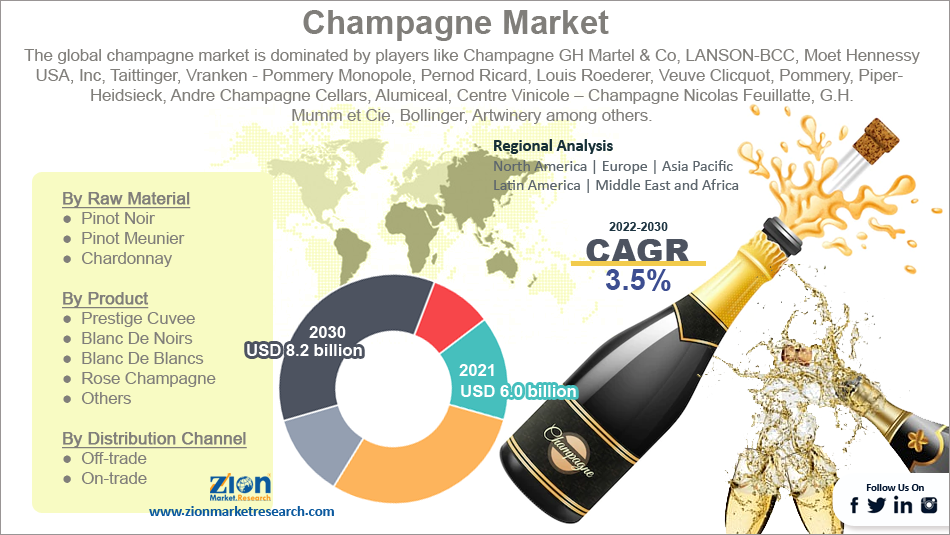Champagne Market Analysis
The global champagne market was worth USD 6.0 billion in 2021 and is expected to increase to USD 8.2 billion by 2030 at a CAGR of 3.5%.
Champagne, a type of sparkling wine, is named after the Champagne area of France, where it is often made. Methode champenoise is the technique used to create this beverage; it entails a secondary fermentation in the bottle. This is what produces the characteristic bubbles and dry flavor of Champagne.
Champagne grapes are often a mix of Chardonnay, Pinot Noir, and Pinot Meunier. Wines of this type often undergo malolactic fermentation in stainless steel tanks and bottle aging for at least 15 months.
Montagne de Reims, Vallée de la Marne, Côte des Blancs, Côte des Bar, and Aube are the five primary vineyard regions in Champagne. Champagne from several regions has varying qualities because of their individual terroir and microclimate.
Champagne is typically reserved for exceptional events like weddings and New Year’s Eve, where its luxurious and celebratory reputation shines. It’s a versatile wine that goes well with anything from seafood to dessert.
From grape yields to bottle size, Champagne is governed by some of the strictest standards in the wine industry. That’s why Champagne is such a luxury item—and why it costs so much.

Champagne Market Growth Factors
- Increasing consumer demand for premium and luxury products: As global economies continue to grow and consumers become more affluent, there is an increasing demand for premium products, such as Champagne.
- Growing popularity of sparkling wines: Sparkling wines, such as Champagne, are becoming increasingly popular around the world, driven by a growing interest in wine culture and the desire to try new and exciting types of wine.
- Global economic indicators: Champagne consumption is highly correlated with economic indicators, such as GDP. During times of economic growth, consumers are more likely to purchase luxury products such as Champagne.
- Innovations in production and marketing: Many Champagne producers are investing in new technologies and marketing strategies to attract new customers and increase sales.
- Expansion of the global market: The globalization of the wine market and the increasing popularity of sparkling wines around the world is leading to the expansion of the Champagne market to new regions and countries.
- The role of Branded products: Champagne is well known for its premium prices and high brand loyalty, which are major driving forces for the market growth.
- The rise of Online sales: The rise of e-commerce has made it easier for consumers to purchase Champagne, which has contributed to the growth of the market.
Champagne Market Regional Analysis
The Champagne market is primarily concentrated in the Champagne region of France, where the majority of Champagne is produced. However, the market is also present in other regions around the world.
- France: The Champagne region of France is the largest market for Champagne, accounting for the majority of production and consumption.
- Europe: Other European countries, such as the United Kingdom and Germany, are also major markets for Champagne.
- North America: The United States is the largest export market for Champagne, with significant consumption in cities such as New York and Los Angeles.
- Asia: Asia, particularly Japan, is an important market for Champagne, with increasing demand driven by the growing middle class and a growing interest in wine culture.
- South America: The market for Champagne in South America is still relatively small, but it is growing in countries such as Brazil and Argentina as the middle class continues to expand.
- Africa and Middle East: The market for Champagne in these regions is relatively small, but it is growing as more consumers in these regions become interested in wine culture.
Overall, the Champagne market is expected to continue growing in the coming years, driven by increasing consumer demand for premium and luxury products, as well as the expansion of the market to new regions and countries.
Champagne Product Types
- Brut: Brut is the driest style of Champagne, with a low sugar content (less than 12 grams of sugar per liter).
- Extra Dry: Extra dry Champagne has a slightly higher sugar content (between 12-17 grams of sugar per liter) than Brut, which gives it a slightly sweeter taste.
- Demi-sec: Demi-sec Champagne has a higher sugar content (between 32-50 grams of sugar per liter) than Brut and Extra Dry, making it the sweetest style of Champagne.
- Rosé: Rosé Champagne is made by blending red and white wines together, or by allowing the grape skins to macerate with the juice for a short period of time.
- Blanc de Blancs: Blanc de Blancs is made exclusively from Chardonnay grapes and it is characterized by its light, floral and citrus flavors.
- Blanc de Noirs: Blanc de Noirs is made exclusively from Pinot Noir and Pinot Meunier grapes, giving it a more robust, earthy and fruity flavor.
- Vintage: Vintage Champagne is made from grapes that were all harvested in the same year, and it is aged for at least three years.
- Non-Vintage: Non-Vintage Champagne is a blend of wines from different years, and it is aged for a shorter period of time.
- Luxury Champagne: Luxury Champagne, also known as prestige cuvée, is a term used to describe the top-of-the-range Champagne produced by a specific house or producer.
Champagne can also be classified by the level of dosage, which refers to the amount of sugar added to the wine before it is sealed with the cork. The classification are: Brut Nature, Extra Brut, Brut, Extra Dry, Sec, Demi-Sec and Doux.
Champagne Market By Raw Material
Champagne is made using a specific blend of three grape varieties: Chardonnay, Pinot Noir and Pinot Meunier.
- Chardonnay: Chardonnay grapes are used to produce the base wine for Blanc de Blancs Champagne, as well as some other styles. Chardonnay grapes are known for their light, floral, and citrus flavors.
- Pinot Noir: Pinot Noir grapes are used to produce the base wine for Blanc de Noirs Champagne, as well as some other styles. Pinot Noir grapes are known for their robust, earthy, and fruity flavors.
- Pinot Meunier: Pinot Meunier grapes are used to produce the base wine for some styles of Champagne. Pinot Meunier grapes are known for their fruity and floral flavors.
In addition to these grape varieties, other raw materials are also used in the production of Champagne, such as yeast and sugar. Yeast is used to initiate the secondary fermentation in the bottle, which gives Champagne its bubbles, and sugar is added to adjust the sweetness of the final product.
Champagne Market Key Players
- Moet & Chandon: Moet & Chandon is one of the most well-known and respected Champagne houses in the world. It is owned by LVMH, one of the largest luxury goods companies in the world.
- Veuve Clicquot: Veuve Clicquot is another major player in the Champagne market, known for its premium and luxury products. It is owned by Moet Hennessy, another subsidiary of LVMH.
- Bollinger: Bollinger is a family-owned Champagne house known for its high-quality, traditional Champagnes.
- Taittinger : Taittinger is a family-owned Champagne house known for its high-quality, traditional Champagnes.
- Laurent-Perrier: Laurent-Perrier is a family-owned Champagne house known for its high-quality, traditional Champagnes.
- Piper-Heidsieck: Piper-Heidsieck is a family-owned Champagne house known for its high-quality, traditional Champagnes.
- Perrier-Jouet: Perrier-Jouet is a family-owned Champagne house known for its high-quality, traditional Champagnes.
- Ruinart: Ruinart is a family-owned Champagne house known for its high-quality, traditional Champagnes.
- G.H. Mumm: G.H. Mumm is a family-owned Champagne house known for its high-quality, traditional Champagnes.
- Nicolas Feuillatte: Nicolas Feuillatte is a family-owned Champagne house known for its high-quality, traditional Champagnes.
However, there are also many smaller producers that make up a significant portion of the market. These smaller producers are usually family-owned and are known for their artisanal and traditional production methods.

